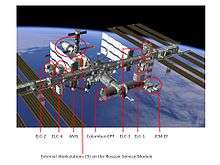Columbus – External Payload Facility
The Columbus External Payload Facility (Columbus-EPF) consists of two identical L-shaped consoles attached to the starboard cone of Columbus in the zenith (top) and nadir (bottom) positions, each supporting two platforms for external payloads or payload facilities. Four external payloads (payload facilities) can be operated at the same time.

The first Columbus-EPF payload facilities were the European Technology Exposure Facility (EuTEF) and Sun Monitoring on the External Payload Facility of Columbus (Solar), which were installed during the STS-122/1E mission during an extravehicular activity (EVA) by crew members. Atomic Clock Ensemble in Space and EXPORT will be delivered to the International Space Station at a later, undetermined date.
In addition to structural support, Columbus can supply power and data (command) to the Columbus-EPF payloads and can poll the payloads for housekeeping (health and status) and user data.
The power and data interfaces available to the Columbus-EPF payloads are directly connected to the Columbus internal distribution systems. Columbus-EPF payloads and payload facilities are controlled and commanded via Columbus using the same data links and ground segment infrastructure used for internal payloads. Each payload has a facility-responsible centre that can transmit commands and receive telemetry via the Columbus Control Centre.
Columbus provides a maximum of 1.25 kW per Columbus-EPF location. Each Columbus-EPF location is connected to two 120-Vdc power feeders, each of which has a maximum allocation of 1.25 kW. Switching between the power feeders is done via the payload power switch box in Columbus and requires the power feeders to be powered down.
The maximum on-orbit mass of an external Columbus-EPF payload, including the adapter plate, is 290 kg. The dimensions of a payload should not exceed 864 x 1168 x 1245 mm without the adapter plate. [1]
Facility operations
The Columbus External Payload Facility (Columbus-EPF) was transported to the International Space Station (ISS) with the Columbus module on STS-122/1E in February 2008. Columbus-EPF payloads and payload facilities are transported to and from orbit using a carrier supplied by the ISS Program. The payloads and payload facilities are manoeuvred by the robotic manipulators of the ISS to their final operational locations on the Columbus-EPF. Each payload or payload facility has an open view to ram and to starboard, as well as one to either zenith or nadir. The view in the wake direction is reduced by ISS structures. At the end of its operational phase, a payload is transported to the carrier by robotic means and returned to ground for post-mission inspection and analysis and, possibly, refurbishment.[1]
Bartolomeo
The Bartolomeo platform will be robotically installed to the outside of the Columbus module from SpaceX CRS-20's trunk. ISS astronauts Chris Cassidy and Bob Behnken will hook up wiring on a spacewalk to ready the structure to host science payloads. ESA is emphasizing its usefulness for commercial entities, academic institutions, and other lower-budget customers.[2][3][4]
Airbus spent about €40 million to develop the Bartolomeo platform, according to DLR, the German space agency. DLR says accommodations on Bartolomeo will be priced from €300,000 to €3.5 million per year. Data from attached experiments will be routed to the ground through the space station's telemetry system, then go into cloud storage, where scientists can access the information with a smartphone. Payload owners can also send commands to their experiments through a smartphone. A German-made laser communications terminal will be added to Bartolomeo in 2021, allowing faster data links between experiments and their operators on the ground. Airbus is also partnering with the United Nations Office for Outer Space Affairs to solicit ideas for Bartolomeo payloads from around the world. Developing countries in particular are encouraged to participate.[5]
Current External Experiments on Columbus
Payloads are installed onto Columbus using Flight Releasable Attachment Mechanisms or FRAMs for short. There are four FRAMs on Columbus; each is currently holding an external payload.
- FRAM 1 (top side) Empty Awaiting ACES
- FRAM 2 (side top pylon) Empty Awaiting EXPORT
- FRAM 3 (side bottom pylon) Atmosphere-Space Interaction Monitor (ASIM)
- FRAM 4 (bottom side) Empty Awaiting GEROS
Deorbited:
- LWAPA/MISSE 6
- EuTEF
- ISS-RapidScat
- SOLAR
- Space Debris Sensor (SDS)
- High Definition Earth Viewing cameras (HDEV)
Related publications
- Persson J, Dettmann J. Columbus External Payload Facility - Architecture and Utilisation. Conference and Exhibit on International Space Station Utilization, Cape Canaveral, FL. Oct 15 - 18, ;AIAA-2001-5068. 2001
See also
- Scientific research on the ISS
References
- "Archived copy". Archived from the original on 2010-03-25. Retrieved 2010-03-26.CS1 maint: archived copy as title (link) Columbus - External Payload Facility (Columbus-EPF)
- Torbet, Georgina (8 March 2020). "ISS Gets a New Research Platform, Bartolomeo, attached to its exterior". Digital Trends.
- Shireman, Kirk. "HEO NAC May 2020 International Space Station Status" (PDF). NASA. Retrieved 2020-05-31.
- Corbett, Tobias (May 19, 2020). "NASA outlines the near and far future of the Space Station". NASASpaceflight.com. Retrieved May 21, 2020.
- Clark, Stephen (6 March 2020). "Space Station to Receive New Outdoor Deck for Science Experiments". Spaceflight Now.
![]()